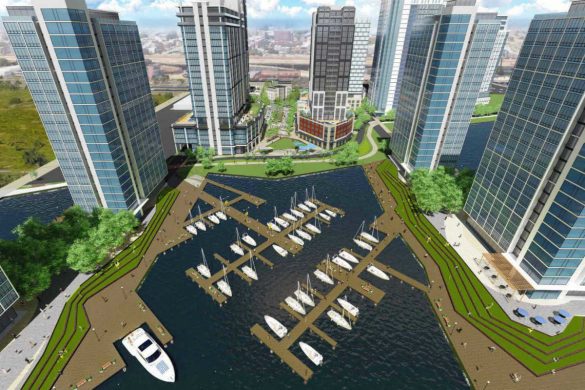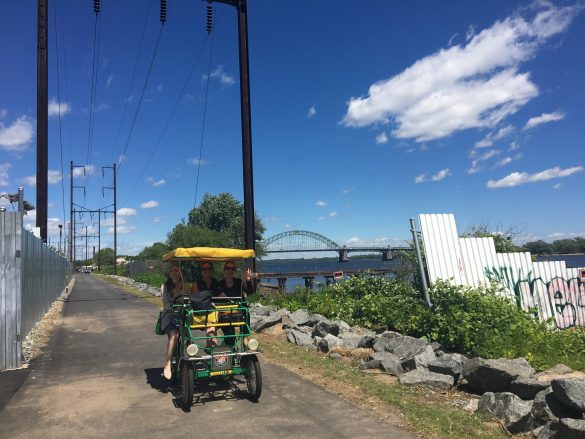With one bill, Squilla undermines a decade of waterfront planning

Philadelphia Inquirer | by Inga Saffron
This fall marks a decade since an extraordinary planning effort brought together hundreds of Philadelphians to rethink the barren industrial wastes of the Central Delaware waterfront. The consensus formed during those meetings, led by Penn Praxis, provided the basis for a new master plan to guide development and a new management agency to implement its recommendations.
All that public engagement could now be cast aside by one person: Councilman Mark Squilla.
Last week, Squilla introduced a bill that threatens to undermine a decade’s worth of systematic waterfront planning. On its face, the bill doesn’t sound particularly awful. It establishes a bunch of tasty zoning bonuses that would enable developers to exceed the height guidelines established by the master plan. The difference isn’t all that great. The top building height on the waterfront would increase from the current 244 feet to around 325 — roughly 25 to 30 stories.
But you know something is fishy in Philadelphia because Squilla slipped the bill onto City Council’s agenda without first consulting with either the Central Delaware manager or the citizens watchdog group.
“We were totally surprised by it,” said Joe Schiavo, vice chair of the citizens group. “We never had an opportunity to develop a position.” The DRWC’s new president, Joe Forkin, told me he didn’t receive a copy of the bill until Monday, five days after Squilla introduced it May 11.
The existing height guidelines have never stopped a developer from realizing a project on the Delaware, Schiavo noted. So why was this bill introduced now, just weeks before Council recesses for the summer?
As Squilla tells it, the bill is necessary to help the developer K4 Associates pull off a massive mixed-use project on an 18-acre site just south of Washington Avenue that is partly owned by the Sheet Metal Workers’ union. Their renderings show 10 high-rise towers ringing a marina. The idea is to create an entirely new neighborhood, with shops and walkable streets on South Philadelphia’s waterfront.
It’s also pure fantasy.
As my colleague Jacob Adelman has reported, K4’s resumé is slim. The company has provided financing for a Dallas hotel and a San Antonio apartment complex but has never attempted anything near the scale of the project depicted in the renderings. Those images, by the way, were produced by Barton Partners, a firm that has made a sideline out of drawing up pretty pictures for speculators. (See Soko Lofts.)
For decades, developers have been obsessed with the idea of creating a glistening, Vancouver-style skyline along the Delaware. But other than Waterfront Square’s three lonely towers, built during the prerecession high-rise mania, no such towers have ever materialized.
There is a reason for that. Because the Delaware waterfront is still not sufficiently linked into the fabric of Center City, the demand for housing there remains limited. Even PMC, one of the city’s most successful residential builders, decided 16 stories (198 feet) was the right height for its One Water Street project next to the Ben Franklin Bridge. Developer Bart Blatstein, who owns the site next to K4’s property, is proposing a townhouse community. If people were clamoring for waterfront high-rises, Blatstein would surely be first in line with a proposal.
Indeed, one of the big aha moments of the master plan process was when economic consultant HR&A Advisors urged the city to give up its Vancouver dreams. The consensus was that the only way the Delaware could ever evolve into a real neighborhood would be if it started small, with urbane mid-rises on a traditional street grid. That doesn’t mean there can’t be the occasional punctuation of a high-rise tower, but the master plan is flexible to allow for such exceptions.
Squilla’s bill actually makes development more difficult to pull off, argued Matt Ruben, who chairs the citizens group. By allowing more density, the site instantly becomes more valuable. At the same time, the more developers pay for land, the more units they need to turn a profit. “The No. 1 reason for the lack of development on the waterfront isn’t restrictive zoning, it’s speculation enabled by irresponsible upzoning,” he explained. “That’s why developers have played musical chairs with these sites for 20 years.”
It’s worth noting here who the beneficiary of that speculation would be: Sheet Metal Workers Local 19 and its former head, Tom Kelly, now a partner with K4. The site is part of the Pennsport neighborhood, home turf of the powerful union leader John Dougherty.
Squilla has told the stakeholders not to sweat the details. He promises that amendments can always be made to the bill after it emerges from Council’s June 13 Rules Committee hearing. How nice that the public still gets to complain about a done deal.
If you want to know a better way to make a waterfront successful, take a trip to the North Delaware. This week, another agency, the Delaware River City Corp., opened a new, mile-long segment of its riverfront greenway, connecting the Frankford boat launch at Magee Street to Lardner’s Point Park, a lush picnic area in the lee of the Tacony-Palmyra Bridge.

Though the Central Delaware has gotten the lion’s share of attention and money, the North Delaware group has been quietly plugging away at its trail network. Following the right-of-way of the former Kensington & Tacony Railroad, the new segment cuts through a gritty stretch of the city that is still lined with active industrial users. For a brief moment during the opening ceremonies, it looked as though some in the crowd might be overcome by the intense aroma of hot dogs emanating from the adjacent Dietz & Watson factory.
Despite the challenging conditions, the agency has managed to finish nearly seven miles of the North Delaware greenway. By 2022, the entire 11-mile greenway should be complete.
How much of the Central Delaware trail has been finished? Just a single mile has been added since 2007 between Oregon and Allegheny Avenues.
“We’re way ahead of the southern part of the trail,” Councilman Bobby Henon bragged during the opening event, referring to the Central Delaware. He told the crowd he likes to rib Squilla, his counterpart in South Philadelphia, about the achievement gap.
Squilla’s new zoning bill will simply widen the gulf.